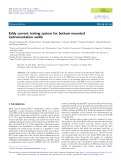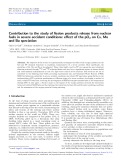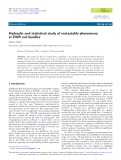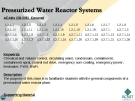
REGULAR ARTICLE
Contribution to the study of fission products release from nuclear
fuels in severe accident conditions: effect of the pO
2
on Cs, Mo
and Ba speciation
Claire Le Gall
1,*
, Fabienne Audubert
1
, Jacques Léchelle
1
, Yves Pontillon
1
, and Jean-Louis Hazemann
2
1
CEA, DEN / DEC, Cadarache, 13108 Saint-Paul-Lez-Durance, France
2
Institut Néel, CNRS –UGA & CRG –FAME, ESRF, 38041 Grenoble cedex 9, France
Received: 30 October 2019 / Accepted: 15 November 2019
Abstract. The objective of this work is to experimentally investigate the effect of the oxygen potential on the
fuel and FP chemical behaviour in conditions representative of a severe accident. More specifically, the
speciation of Cs, Mo and Ba is investigated. These three highly reactive FP are among the most abundant
elements produced through
235
U and
239
Pu thermal fission and may have a significant impact on human health
and environmental contamination in case of a light water reactor severe accident. This work has set out to
contribute to the following three fields: providing experimental data on Pressurized Water Reactor (PWR)
MOX fuel behaviour submitted to severe accident conditions and related FP speciation; going further in the
understanding of FP speciation mechanisms at different stages of a severe accident; developing a method to
study volatile FP behaviour, involving the investigation of SIMFuel samples manufactured at low temperature
through SPS. In this paper, a focus is made on the impact of the oxygen potential towards the interaction
between irradiated MOX fuels and the cladding, the interaction between Mo and Ba under oxidizing conditions
and the assessment of the oxygen potential during sintering.
1 Introduction
At the time of rising concerns about greenhouse gases
emission and confronted to an increase of the world needs in
energy, nuclear power appears as a sustainable solution
that intends to develop across the world. Guaranteeing the
safety and security of the existing and future nuclear
facilities is thus a top priority. Nowadays, 65% of the
nuclear reactors in the world are PWR. These very
complex facilities are composed of fuel pellets (UO
2
or
MOX (U,Pu)O
2
) piled up in a Zirconium (Zr) alloy
cladding tubes placed in a vessel containing water at
around 350 °C under 150 bars. These pellets are thus
submitted to important strains (temperature, pressure,
radiation, etc.) linked to both the fission reaction of heavy
nuclei they contained and to the reactor’s design.
Despite the constant improvements made on the safety
systems implemented in the reactors, failures might
happen and lead, in very rare cases, to nuclear severe
accidents. These events, implying melting of all or part of
the nuclear core, might also lead to radioactive materials
release in the environment, as demonstrated in the cases of
Chernobyl (1986) and Fukushima-Daiichi (2011). In
addition, the damaged core remains hardly accessible even
years after the accident because of the radiations it is still
emitting. Among the numerous elements that are poten-
tially released during such an accident, some fission
products have a strong radiological impact. Moreover,
their volatility can vary due to their high chemical
reactivity and the physical-chemical evolution of the fuel.
It is notably the case of Cesium (Cs), Molybdenum (Mo)
and Barium (Ba).
Quantify the source term, corresponding to the nature
and quantity of radioactive materials released during a
severe accident, is thus a critical issue to:
–precisely estimate the consequences on populations and
the environment,
–take decisions in term of crisis management,
–understand the chronology of the accident and predict
the final state of the reactor’s core,
–securely dismantle the facility in the long term.
To do so, models are developed and validated thanks to
the results of experimental programs aiming at reproducing
and understanding some phenomena occurring during a
*e-mail: legall.claire1@gmail.com
EPJ Nuclear Sci. Technol. 6, 2 (2020)
©C. Le Gall et al., published by EDP Sciences, 2020
https://doi.org/10.1051/epjn/2019058
Nuclear
Sciences
& Technologies
Available online at:
https://www.epj-n.org
This is an Open Access article distributed under the terms of the Creative Commons Attribution License (https://creativecommons.org/licenses/by/4.0),
which permits unrestricted use, distribution, and reproduction in any medium, provided the original work is properly cited.
























